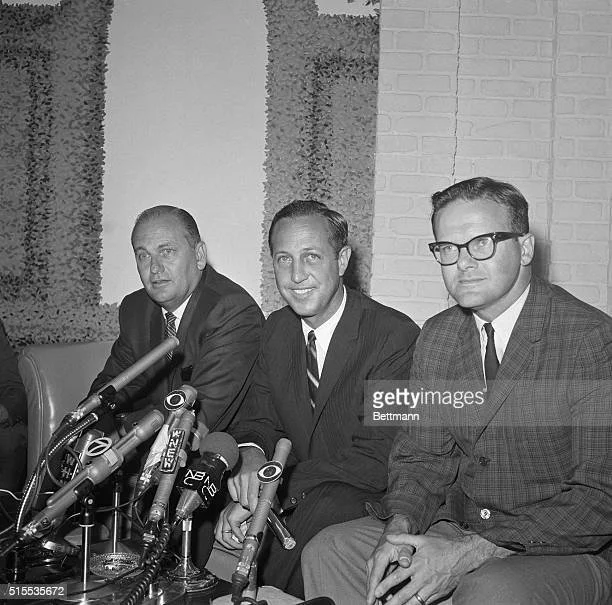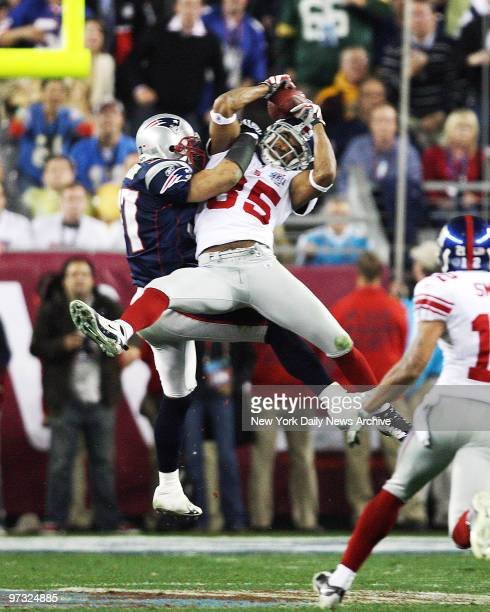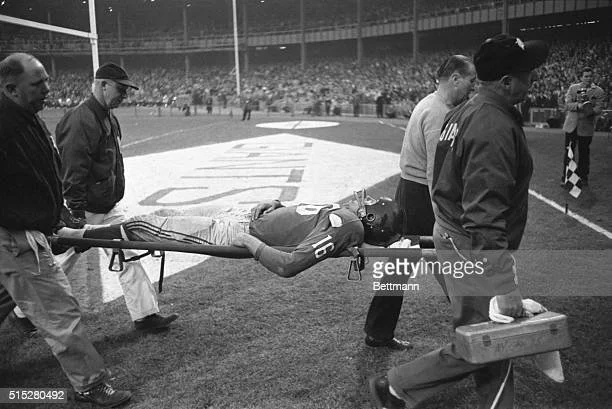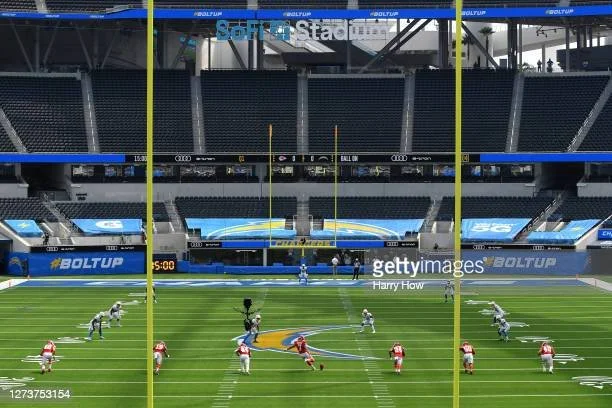THE HISTORY OF THE NFL
The National Football League (NFL) was founded in 1920, originally going by the name of the American Professional Football Association (APFA). For the 1922 season, they renamed themselves to the name we know today: the NFL.
Johnny Unitas #19 (Left) about to make a pass to his teammate in what is considered to be ‘Te Greatest Game Ever Played.’ This 1958 NFL Championship Game at New York’s Yankee Stadium was between the Baltimore Colts and the New York Giants. (Picture taken by Robert Riger)
The league originally consisted of teams from the Midwest, but it has since grown to include teams from all over the United States.
Instability marks the early years of the NFL, with many teams forming, folding, and relocating. Stable membership was not established until the 1940s and 1950s.
College football competed in popularity and caused the NFL to struggle financially over many years. However, it began to grow in popularity in the 1930s thanks to several key developments.
The first NFL championship game, which pitted the Chicago Bears against the Portsmouth Spartans, was played in 1933. It drew a crowd of more than 26,000 fans and established the league as a major sports entity.
The Chicago Bears at Soliders Field on December 21st, 2014, prior to a game against the Detroit Lions. (Photo by Jamie Squire/Getty Images)
During the 1940s and 1950s, the NFL continued to grow in popularity, with several iconic players and teams emerging during this time. The 1950s also saw the beginning of the NFL's national television broadcasts, which helped to further increase the league's popularity.
In 1960, the NFL and AFL announced that they would merge, with the AFL becoming a part of the NFL in 1970. Merging helped further propagate the NFL as the dominant professional football league in the United States.
President of the NFL Tex Schramm (Left), NFL Commissioner Pete Rozelle (Middle), and founder of the AFL Lamar Hunt (Right) during a press conference after announcing the merge of the NFL and AFL. (Bettman Archives/Getty Images)
The NFL continued to evolve in the 1970s and 1980s, with the advent of free agency and the increasing use of sophisticated offensive strategies. The league also expanded to 28 teams in the 1970s. In the 1990s it further expanded to 32 teams, where it is at today.
One of the most effective ways of increasing the popularity of the league was The Super Bowl. First played in 1967, it quickly became one of the biggest events in American culture. Huge television audiences were drawn in to the growing cultural hype and the elaborate halftime shows.
Currently the NFL is considered one of the most popular sports leagues in the world. The annual Super Bowl is played in early February and is one of the most watched television events in the United States.
David Tyree #85 of the New York Giants makes a catch versus the New England Patriots at the University of Phoenix Stadium during Super Bowl 42. (Photo by Michael Appleton/NY Daily News Archive via Getty Images)
Continuing to evolve, the NFL has implemented several rule changes to improve player safety, such as changing the kickoff rules and implementing stricter penalties for helmet-to-helmet hits.
Frank Gifford #16 of the New York Giants being carried off the field with a severe concussion in during a game against the Philadelphia Eagles in 1960. (Bettman Archives/Getty Images)
The league has also taken steps to increase diversity and inclusion, such as implementing the Rooney Rule, which requires teams to interview minority candidates for head coaching and general manager positions.
In the 21st century, the NFL has continued to see steady growth in popularity and revenue. The league has expanded its international reach, with regular season games being played in London and Mexico City. The league has also continued to make use of technology, such as instant replay, and data analysis to improve the game.
NFL Referee Ron Winter (Right) and side judge Tom Hill (Left) review an instant replay during a game between the Pittsburgh Steelers and Cincinnati Bengals at Heinz Field on November 20th, 2008. (Photo by George Gojkovich/Getty Images)
The league has also faced some controversies over the years, such as the handling of player protests during the national anthem and the issue of player safety, including the long-term effects of concussions. These issues have led to changes in the league's policies and procedures, as well as increased attention on player safety and welfare.
In 2020, the NFL had to face a new challenge with the outbreak of COVID-19. The league had to adapt to new safety protocols, and had to play games without fans in the stadiums, which affected the revenues of the teams. Nevertheless, the NFL overcame the many barriers and successfully persevered.
Game between the Kansas City Chiefs and Los Angeles Chargers at SoFi Stadium on September 20th, 2020 in the midst of the Covid-19 pandemic. (Photo by Harry How/Getty Images)
Overall, the NFL has a rich history, with many iconic moments, legendary players, and memorable games. It has grown from a regional league to become one of the most popular and profitable sports leagues in the world. The league continues to evolve and adapt to the changing world, while preserving a rich history and developing a bright future.






